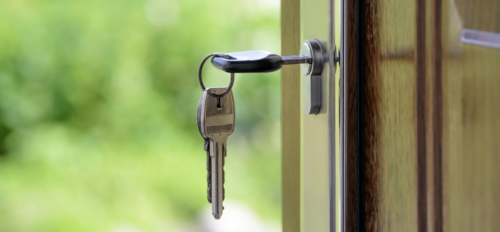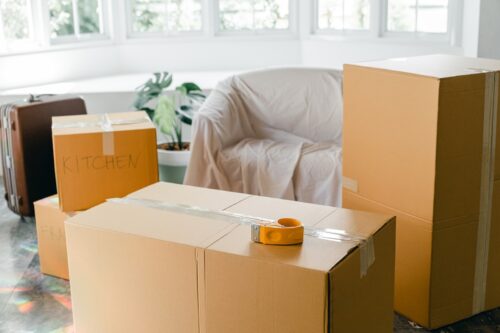Roommates can be a lot of things: best friends, acquaintances, or worst of all (and perhaps all too commonly) noisy! Living with other people means learning to coexist peacefully—but, the fact that we’re all unique individuals with our own schedules and hobbies can make it difficult! Whether your roommate is a night owl or an aspiring guitar legend, you’re going to want to establish some parameters for noise control if you ever hope to catch some z’s. But if you’re spending over a thousand dollars on rent every month, the last thing you want to do is spend extra money to soundproof your apartment.
Schedule a pickup with Clutter now!
Understanding Soundproofing
Soundproofing involves using materials and methods to block or reduce sound waves from traveling between spaces. It encompasses a range of techniques that either prevent sound from entering or leaving a space or improve the acoustic quality within a room. This can involve structural changes, specialized materials, and strategic placement to achieve the desired level of noise control.
Core Principles of Soundproofing: Mass, Damping, Decoupling, and Absorption
Mass: The principle of mass involves adding heavy, dense materials to walls, floors, or ceilings to block sound waves. The heavier and thicker the material, the better it can block sound. Examples include using multiple layers of drywall, mass-loaded vinyl, or dense fiberboard.
Damping: Damping, a crucial technique in soundproofing, refers to the use of materials that dissipate vibrational energy from sound waves, converting it into a small amount of heat. This significantly reduces the amount of sound that travels through walls or floors. Products like Green Glue are commonly used damping compounds applied between layers of drywall to enhance soundproofing.
Decoupling: It involves separating structures to prevent sound waves from traveling through them. This can be done by creating a double wall with a gap in between or using resilient channels to separate drywall from studs. By breaking the path of sound vibrations, decoupling significantly reduces sound transmission.
Absorption: Absorption, a key technique in soundproofing, uses porous materials to soak up sound waves, reducing echo and reverberation within a room. Acoustic panels, foam, carpets, and curtains are examples of absorptive materials that can significantly improve sound quality by reducing internal noise reflections.
Situations Where Soundproofing is Advantageous
Soundproofing can enhance various environments by providing noise control:
Home Office: Ensuring a quiet workspace free from household noise and external distractions enhances concentration and productivity.
Music Studio: To create an acoustically controlled environment for recording and practicing music, ensuring high-quality sound and preventing sound leakage.
Bedroom: Soundproofing can bring a sense of calm and relaxation by creating a peaceful sleeping environment, blocking out outside noises, such as traffic or noisy neighbors, and improving sleep quality.
Learn more: 5 Home Repairs You Can DIY—And 5 You Should Hire a Pro
Fortunately, there are several affordable measures you can take to drown out sound so you can sleep, well, soundly.
Do it yourself.

According to a recent survey by mobile banking company, Chime, 54% of Americans are living paycheck-to-paycheck. When a professional soundproofing job can cost up to $2,598, you’ll wonder if sleeping is even worth it! However, soundproofing doesn’t have to break the bank if you do it yourself. If you deduct the cost of premium materials and installation, you just might find it’s affordable when you’re ready to tackle the problem.
Locate the source.
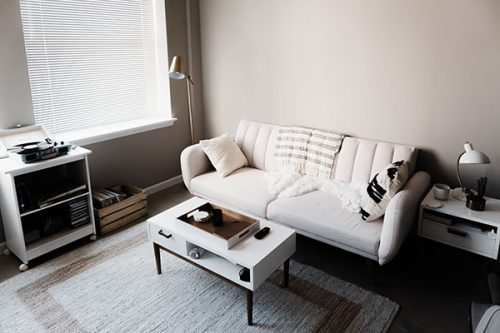
In order to address a noise problem, you need to first find the source of the noise. Remember, sound is a vibration that can travel through air or other mediums (like your wall). So, obstructing the flow of this vibration is how you’ll be able to tackle the problem most effectively. Is the source of noise coming from the wall you and your roommate share? Or perhaps the city slickers outside decided to make their favorite hangout spot below your window. Either way, you’ll want to address the major culprits of your problem before spending the money on insufficient solutions.
Dealing with walls.
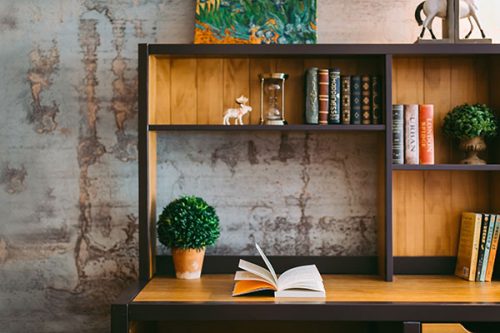
If you’ve pinpointed the source of noise in your walls, there are several things you can do. A bookshelf provides a thick layer, which will make it harder for sound to permeate your wall. Depending on its thickness, a bookshelf is one of the most effective noise disruptors. Hanging textiles, rugs, or acoustic panels (designed specifically for soundproofing) on your walls will achieve a similar result—but will vary in terms of cost and soundproofing effectiveness. As a general rule of thumb, the thicker and denser the object, the better proofing!
Learn more: How To Turn Unused Photos into Decorative Wall Murals
Dealing with windows.
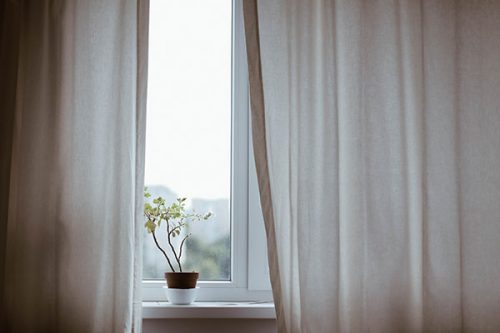
It could very well be that the source of your problem is due to frequent street noise, or a neighbor that likes to mow a little too often. Unfortunately for us stargazers, covering up your windows may be the best solution for your sound troubles. For most apartment dwellers, replacing windows with a triple pane is usually not an option (although if it is, it’s certainly something to consider!). Therefore, you should look to cover your windows with the heaviest or thickest drapes you can find. There are also some options that are removable (like a barrier quilt), allowing you to hang them up only during the periods you find loudest.
Learn more: 7 tips to keep windows squeaky clean
Dealing with doors.
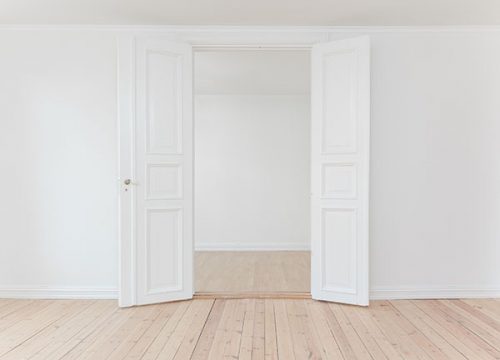
Perhaps your walls aren’t the problem, and you’ve found the ruckus is coming from a shared common area, kitchen, or hallway. In this case, you’ll want to do something about your door. Many of the same soundproofing solutions for your walls apply to your doors as well, the major difference being the large space underneath your door. Sealing this will work wonders for preventing sound from leaking through. If this happens to be you, consider splurging on a draft stopper or installing a door sweep on both sides of the door. Both will have the same effect, and will ultimately help you get back to sleep in no time!
Soundproofing vs. Sound Absorption
While soundproofing focuses on blocking or reducing noise from entering or leaving a space, sound absorption enhances the acoustic environment within a room. Imagine entering a bustling café where conversations, music, and clattering dishes create a cacophony. Now, picture stepping into a serene library where every whisper is distinct and clear. This difference is due to sound absorption.
Sound absorption includes the use of materials that soak up sound waves, preventing them from bouncing around and creating echoes and reverberation. These materials, such as acoustic panels, foam, carpets, and heavy curtains, act like sponges for sound. They don’t stop noise from coming into or leaving a room, but they play a crucial role in significantly improving the sound quality within it, making them practical and effective solutions for a pleasant acoustic environment.
Think of soundproofing as building a fortress around your space, keeping unwanted noise out, and ensuring your activities don’t disturb others. On the other hand, sound absorption is like furnishing your fortress with soft, plush interiors that make every sound inside more pleasant and straightforward. Together, these two techniques create a quiet and acoustically pleasing environment, making your space a haven of tranquility and clarity.
Identifying the Root of Noise
Effective soundproofing begins with identifying the sources of noise. Common sources include:
- External Noise: Traffic, airplanes, construction activities.
- Internal Noise: HVAC systems, appliances, footsteps, conversations.
- Structural Noise: Vibrations and sounds transmitted through walls, floors, and ceilings.
Learn more: 5 Tips to Sleep Through Noise
Effective Strategies for Soundproofing a Room
Walls
- Adding Mass: Install additional layers of drywall or mass-loaded vinyl to increase the wall’s density and block sound transmission.
- Insulation: Soundproof insulation, such as fiberglass or rock wool, should be used within the wall cavities to absorb sound and reduce transmission.
- Damping Compounds: Apply damping compounds like Green Glue between layers of drywall to dissipate vibrational energy.
Floors
- Carpets and Rugs: Lay thick carpets or area rugs to absorb sound and reduce noise transmission through floors.
- Underlayment: Use soundproof underlayment beneath hardwood or laminate flooring to dampen sound and prevent it from passing through the floor structure.
- Floating Floors: Consider installing a floating floor system, which decouples the flooring from the subfloor, reducing sound transmission.
Ceilings
- Drop Ceilings: Install a drop ceiling with acoustic tiles to create an additional barrier against sound transmission.
- Insulation: Add soundproof insulation in the ceiling cavity to absorb sound and reduce noise transfer between floors.
- Damping Compounds: Use damping compounds between layers of ceiling materials to enhance soundproofing.
Windows
- Double Glazing: To reduce sound transmission, install double-glazed windows, which have two layers of glass with an air gap between them.
- Window Inserts: Use soundproof window inserts to add an extra sound insulation layer without replacing existing windows.
- Heavy Curtains: Hang thick curtains to block sound and reduce noise from entering through windows.
Doors
- Solid Core Doors: Replace hollow core doors with solid core doors, which are denser and more effective at blocking sound.
- Weatherstripping: Seal gaps around the door frame with weatherstripping to prevent sound from leaking through.
- Door Sweeps: Fix door sweeps at the bottom of doors to block sound from entering or leaving through the gap beneath the door.
Learn more: How to Soundproof your Apartment
When DIY Soundproofing is a Good Option
DIY soundproofing is a viable option for minor noise issues or when budget constraints are a concern. Simple measures like installing weatherstripping, adding rugs, and hanging heavy curtains can significantly reduce noise without professional help.
DIY projects can also address specific noise sources incrementally.
Perks of Hiring a Professional
Hiring a professional can be beneficial for complex soundproofing needs or when achieving optimal results is critical.
Professionals can accurately identify noise sources, recommend the best materials and techniques, and ensure proper installation.
Their expertise can save time, avoid common mistakes, and achieve higher soundproofing.
Cost Considerations and Budgeting
Soundproofing costs vary based on the extent of work, materials used, and whether you hire professionals. Budgeting involves considering:
- Materials: Costs of soundproofing materials like mass-loaded vinyl, acoustic panels, and damping compounds.
- Labor: If hiring professionals, labor costs will be a significant part of the budget. Remember, professional labor is crucial for a successful soundproofing project, ensuring quality and durability.
- The extent of Soundproofing: The level of soundproofing required—basic measures may be relatively inexpensive, while comprehensive soundproofing can be costly.
Common Miscalculations to Avoid
- Ignoring Small Gaps: Small gaps and cracks can significantly undermine soundproofing efforts, allowing sound to pass through.
- Using Inadequate Materials: Choosing suitable materials, such as lightweight or porous substances, can lead to effective soundproofing.
- Overlooking Vibration Sources: Not addressing vibration sources, like poorly installed HVAC systems, can reduce the effectiveness of soundproofing measures.
By understanding these principles and strategies, you can effectively soundproof your space through DIY efforts or professional assistance. Soundproofing enhances comfort, privacy, and functionality in various environments, making it a valuable investment for many settings.
Schedule a pickup with Clutter now!
FAQs for How To Soundproof a Room
Can I soundproof a room on a limited budget?
Yes, soundproofing a room on a limited budget is possible. Start with affordable solutions like weatherstripping doors and windows, using thick rugs and curtains, and applying acoustic panels or foam. These measures can significantly reduce noise without the need for expensive materials.
Can I soundproof a room without making permanent changes?
Absolutely. There are several non-permanent soundproofing options available. Use removable acoustic panels, heavy curtains, and rugs. Draft stoppers and door sweeps can also be used to block noise without causing permanent alterations to your space.
Is it possible to soundproof a room in a rented apartment?
Yes, you can soundproof a rented apartment using temporary methods. Opt for solutions like installing soundproof curtains, applying removable acoustic panels, and using door sweeps. These methods are effective and won’t damage the property, keeping you in line with rental agreements.
How can I soundproof a room with minimal aesthetic changes?
You can soundproof a room while maintaining its aesthetics by using discreet solutions like acoustic paint, decorative acoustic panels, and thick, stylish curtains. These methods blend seamlessly with your decor while providing effective soundproofing.
Do soundproofing materials affect room temperature?
Some soundproofing materials can have an impact on room temperature. Insulation materials used for soundproofing, such as fiberglass or rock wool, also have thermal properties that can help maintain room temperature by reducing heat loss or gain. However, this effect is generally secondary to their soundproofing capabilities.




